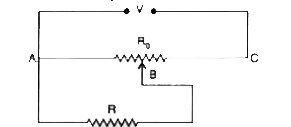An electron is revolving around the nucleus with a constant speed of 2.2×108m/s. Find the de-Broglie wavelength associated with it.Solution in Kannada
λ=hmv
=6.63×10−349.1×10−31×2.2×108
=3.31×10−12m
Topper's Solved these Questions
- DUAL NATURE OF RADIATION AND MATTERBOOK - OSWAAL PUBLICATIONCHAPTER - DUAL NATURE OF RADIATION AND MATTEREXERCISE - TOPIC-2 DE-BROGLIE RELATION (SHORT ANSWER TYPE QUESTIONS-II)
2 Videos
- DUAL NATURE OF RADIATION AND MATTERBOOK - OSWAAL PUBLICATIONCHAPTER - DUAL NATURE OF RADIATION AND MATTEREXERCISE - TOPIC-2 DE-BROGLIE RELATION (LONG ANSWER TYPE QUESTIONS)
1 Videos
- DUAL NATURE OF RADIATION AND MATTERBOOK - OSWAAL PUBLICATIONCHAPTER - DUAL NATURE OF RADIATION AND MATTEREXERCISE - TOPIC-2 DE-BROGLIE RELATION (VERY SHORT ANSWER TYPE QUESTIONS)
8 Videos
- CURRENT ELECTRICITY BOOK - OSWAAL PUBLICATIONCHAPTER - CURRENT ELECTRICITY EXERCISE - TOPIC-3 (POTENTIOMETER & APPLICATIONS) (NUMERICAL PROBLEMS)
2 Videos
- ELECTRIC CHARGES & FIELDSBOOK - OSWAAL PUBLICATIONCHAPTER - ELECTRIC CHARGES & FIELDSEXERCISE - (TOPIC -2)Numerical Problems
5 Videos
Similar Questions
An electron and a photon each have a wavelength of 1.00 nm. Find (i) their momentum (ii) the energy of the photon and (iii) K.E of electron
View SolutionWhat are matter waves? Derive an expression for the de Broglie wave length.
View SolutionA proton and an electron have same kinetic energy. Which one has smaller de-Broglie wavelength ?
View SolutionA resistance of RΩ draws current from a potentiometer. The potentiometer has a total resistance R0Ω.A voltage V is supplied to the potentiometer. Derive an expression for the voltage across R when the sliding contact is in the middle of the potentiometer.

View SolutionAn atom was earlier assumed to be sphere of radius a having a positively charged point nucleus of charge +Ze at its centre . This nucleus was believed to be surrounded by a uniform desity of negative charge that made the atom neutral as a whole.
Use this theorem to find the electric field of this atom at a distance r(r>a) from the centre of the atom.
View SolutionShow that the circumference of the Bohr orbit for the hydrogen atom is an integral multiple of the de Broglie wavelength associated with the electron revolving around the orbit.
View Solution104 वोल्ट से त्वरित इलेक्ट्रॉन से सम्बद्ध दे-ब्रोग्ली तरंग दैर्ध्य ज्ञात कीजिए।
View SolutionThe de-Broglie wavelength associated with electrons revolving round the nucleus in a hydrogen atom in the ground state will be
View SolutionShow that the circumference of the Bohr orbit for the hydrogen atom is an integral multiple of the de Broglie wavelength associated with the electron revolving around the orbit.
View SolutionFind the de-Broglie wavelength of an electron moving with a speed of 5.2×105m/s
View Solutionउस इलेक्ट्रॉन की दे-ब्रॉग्ली तरंगदैर्घ्य क्या होगी जो 1.20×105 मीटर/से के वेग से गतिमान है ?
View SolutionShow that the circumference of the Bohr orbit for the hydrogen atom is an intergral multiple of the de Broglie wavelength associated with the electron revolving around the orbit.
View SolutionAn electron is revolving around the nucleus with a constant speed of 2.2xx10^(6)ms^(-1) . Find the de-Broglie wavelength associated with it.
View SolutionShow that the circumference of the Bohr orbit for the hydrogen atom is an integral multiple of the de Broglie wavelength associated with the electron revolving around the orbit.
View SolutionEstimate the de-Broglie wavelength associated with the motion of earth orbiting around the sum at a speed of 3 xx 10^6 m//s .
View Solution
